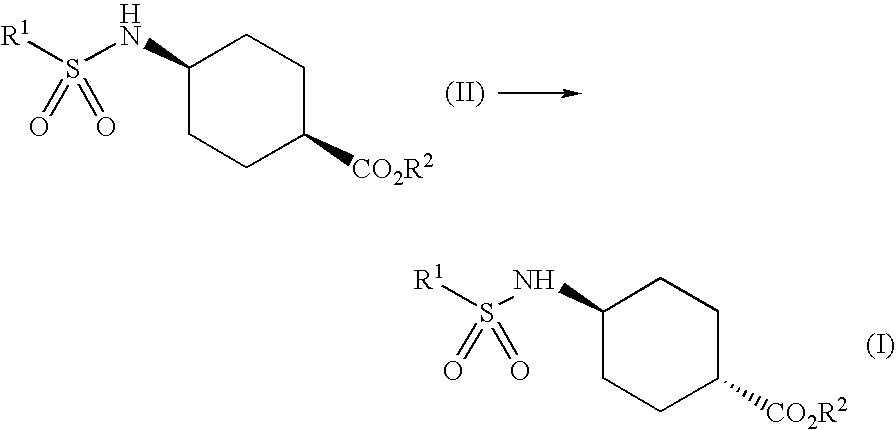Process for trans-4-amino-1-cyclohexanecarboxylic acid derivatives
a technology of cyclohexanecarboxylic acid and process, which is applied in the preparation of amino-carboxyl compounds, organic chemistry, biocide, etc., can solve the problems of not satisfying the process and only achieving the isomerization yield of 40%
- Summary
- Abstract
- Description
- Claims
- Application Information
AI Technical Summary
Benefits of technology
Problems solved by technology
Method used
Image
Examples
reference example 1
Synthesis of 2-methylpropane-2-sulfinylchloride (3)
(1) 2-Methylpropane-2-sulfinic Acid (2)
[0181]Sulfurous acid gas (162 g, 1.23 eq) was introduced into a solution of t-butyl magnesium chloride (1) in tetrahydrofuran (2 mol / L, 1 kg, 2.06 mol) with cooling at 2 to 20° C. Two lots obtained in the same manner were combined, poured into a mixture of ice, concentrated hydrochloric acid and toluene, and extracted. Toluene layer was washed with saturated brine and each of aqueous layer was extracted with toluene. Toluene layers were dried over sodium sulfate, concentrated under reduced pressure to obtain a solid residue of (2) (396 g, 78.7%).
(2) 2-Methylpropane-2-sulfinyl Chloride (3)
[0182]Thionyl chloride (460 mL) was added dropwise to a solution of (2) (700 g, 5.729 mol) in anhydrous tetrahydrofuran (3 L) at ice cooling and the mixture was stirred for 30 minutes at the same temperature. The reaction mixture was concentrated under reduced pressure to obtain a solid residue (3) (900 g).
[018...
reference example 2
Synthesis of Methyl cis-4-amino-1-cyclohexane Carboxylate Hydrochloride (7)
[0189]Thionyl chloride (301 mL, 0.6 eq) was added dropwise to a suspension of cis-4-amino-1-cyclohexane carboxylic acid (6) (984 g, 6.87 mol) in methanol (4.82 L) and stirred for 6 hours at room temperature, and the mixture was allowed to be stand for 3 days. The reaction mixture was concentrated under reduced pressure and isopropyl ether was added to the mixture. The appeared crystals were collected by filtration to obtain methyl cis-4-amino-1-cyclohexane carboxylate hydrochloride (1086 g, 81.6%). The mother liquor was concentrated under reduced pressure and methanol (50 mL) and isopropyl ether (1.0 mL) were added to the residue. The appeared crystals were collected by filtration to obtain second crystals of (7) (94 g, 7.0%).
[0190]mp. 172-174° C., Anal. Calcd for C8H16NO2Cl C, 49.61; H, 8.33; N, 7.23; Cl, 18.31, Found C, 49.17; H, 8.27; N, 7.33; Cl, 18.19, H2O>0.1% 1H NMR (CD3OD): δ 1.40-1.50 (m, 4 H), 1.85-...
example 1
Synthesis of Methyl trans-4-(2-methylpropane-2-sulfonylamino)cyclohexane Carboxylate (12) (via Compound (15))
(1) Methyl cis-4-(2-methylpropane-2-sulfinylamino)cyclohexane Carboxylate (14)
[0191]Triethylamine (272 mL) was added dropwise to a suspension of methyl cis-4-amino-1-cyclohexane carboxylate hydrochloride (7) (151 g, 0.78 mol) and 2-methylpropane-2-sulfinyl chloride (3) (120.8 g, 1.1 eq) in ethyl acetate (755 mL) at 6 to 9° C. The mixture was stirred for an hour at the same temperature and poured into diluted hydrochloric acid. The mixture was extracted with ethyl acetate (750 mL×2) and each of organic layers was washed with water, 5% aqueous solution of sodium bicarbonate, water and brine, successively. The solvent was concentrated under reduced pressure to obtain oily (14) (222.7 g, 109%).
(2) Methyl cis-4-(2-methylpropane-2-sulfonylamino)cyclohexane Carboxylate (15)
[0192]After an aqueous solution of ammonium molybdate tetrahydrate (28.9 g, 0.03 eq) (100 mL) was added to a so...
PUM
| Property | Measurement | Unit |
|---|---|---|
| Reaction temperature | aaaaa | aaaaa |
| Reaction temperature | aaaaa | aaaaa |
| Reaction time | aaaaa | aaaaa |
Abstract
Description
Claims
Application Information
 Login to View More
Login to View More - R&D
- Intellectual Property
- Life Sciences
- Materials
- Tech Scout
- Unparalleled Data Quality
- Higher Quality Content
- 60% Fewer Hallucinations
Browse by: Latest US Patents, China's latest patents, Technical Efficacy Thesaurus, Application Domain, Technology Topic, Popular Technical Reports.
© 2025 PatSnap. All rights reserved.Legal|Privacy policy|Modern Slavery Act Transparency Statement|Sitemap|About US| Contact US: help@patsnap.com



